Research: Quantum foundations, quantum information theory and quantum cryptography
These are my main current research interests. Most of my papers on these subjects are on the physics arxiv. Some of the research topics I've worked on, and relevant papers and talks, are described below. (These descriptions and lists are incomplete: work in progress. Note that some papers belong in more than one list.)
Relativistic Quantum Cryptography
Talks
My talk on relativistic quantum cryptography at QCRYPT 2012 is
here.
Our collaborative
paper
on an experimental implementation of bit commitment
using quantum information and relativistic signalling constraints
was presented at QCRYPT 2013.
Papers
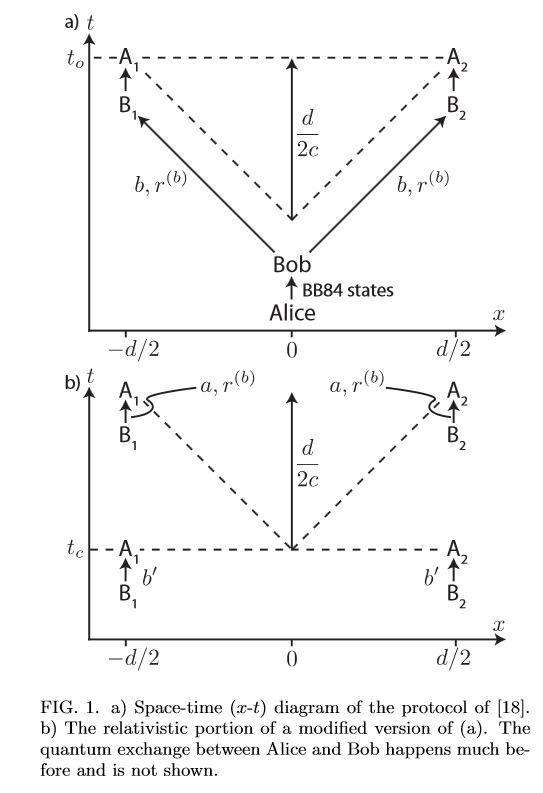
A Quantum Paradox of Choice: More Freedom Makes Summoning a Quantum
State Harder
Device-independent relativistic quantum bit commitment
Deterministic relativistic quantum bit commitment
Experimental bit commitment based on quantum communication and special
relativity
Security Details for Bit Commitment by Transmitting Measurement Outcomes
Secure and Robust Transmission and Verification of Unknown Quantum
States in Minkowski Space
Fundamental quantum optics experiments conceivable with satellites -- reaching relativistic distances and velocities
Quantum Tasks in Minkowski Space
Unconditionally Secure Bit Commitment by Transmitting Measurement Outcomes
Location-Oblivious Data Transfer with Flying Entangled Qudits
Unconditionally Secure Bit Commitment with Flying Qudits
A No-summoning theorem in Relativistic Quantum Theory
Quantum Tagging for Tags Containing Secret Classical Data
Quantum Tagging: Authenticating Location via Quantum Information and Relativistic Signalling Constraints
Variable Bias Coin Tossing
Why Classical Certification is Impossible in a Quantum World
Unconditionally Secure Commitment of a Certified Classical Bit is Impossible
Secure Classical Bit Commitment using Fixed Capacity Communication Channels
Unconditionally Secure Bit Commitment
Coin Tossing is Strictly
Weaker Than Bit Commitment
Related Experimental Work
The paper
Experimental bit commitment based on quantum communication and special
relativity
describes a collaboration between experimentalists and theorists
based in Geneva, Cambridge and Singapore to implement (a variation
of) one of my
protocols for bit commitment using quantum information and
relativistic signalling constraints and to analyse its security
under realistic practical conditions.
Another group also recently experimentally implemented my protocol on a
smaller scale; their work is described
here .
Commentaries
Our Physical Review Letter reporting the experimental implementation
of relativistic quantum bit commitment
was highlighted as an Editor's Suggestion.
The accompanying American Physical Society Focus article is
here.
Cambridge University's news article on the work is
here.
Relativistic Quantum Information Theory
A Quantum Paradox of Choice: More Freedom Makes Summoning a Quantum
State Harder
A No-summoning theorem in Relativistic Quantum Theory
Quantum Tasks in Minkowski Space
Commentaries
Our quantum paradox of choice was reported in
Science News. (Full article requires subscription.)
Quantum Key Distribution with security based (only) on
No-Signalling
Papers
Unconditionally secure device-independent quantum key distribution
with only two devices
Maximally Non-Local and Monogamous Quantum Correlations
No Signalling and Quantum Key Distribution
Talks
Our results on unconditionally secure device-independent quantum key distribution with only two devices were presented at QIP 2013. Here are the slides of Roger Colbeck's talk.
Device-Independent Quantum Cryptography
Papers
Unconditionally secure device-independent quantum key distribution
with only two devices
Prisoners of their own device: Trojan attacks on device-independent quantum cryptography
Maximally Non-Local and Monogamous Quantum Correlations
No Signalling and Quantum Key Distribution
Talks
Roger Colbeck's talk at QCRYPT 2012 on our joint work with Jonathan Barrett on memory attacks on device-independent quantum cryptography is here.
Commentaries The MIT Technology Review blog's report on the above work. Note our author correction letter published below the original article. (The originally posted article wrongly suggested our attacks apply to all types of quantum cryptography rather than specifically to device-independent implementations by parties who cannot rely on any property of the quantum devices they are using).
Quantum Randomness Expansion
Roger Colbeck and I invented the idea of quantum randomness expansion,
first described and discussed in
Roger's PhD thesis.
Our joint work on this is here:
Private Randomness Expansion With Untrusted Devices
Quantum Tagging (Quantum Position Authentication)
Papers
Quantum Tagging for Tags Containing Secret Classical Data
Quantum Tagging: Authenticating Location via Quantum Information and
Relativistic Signalling Constraints
Commentaries
A piece by Gilles Brassard in Nature on this topic is here. (Link requires subscription.)
Quantum Digital Signature Schemes
Erika Andersson and collaborators have invented some very
interesting schemes that use quantum information -- or
data generated from quantum information -- to securely
sign messages. Their schemes have significant security
and efficiency advantages over earlier quantum digital
signature schemes, and are well adapted for practical
implementation. I was happy to join them
in developing some of this research further:
Quantum digital signatures with quantum key distribution components
Secure Quantum Signatures Using Insecure Quantum Channels
Other Work on Quantum Cryptography
The following papers are on "ordinary" quantum cryptography, i.e.
forms of security obtainable from the properties of quantum
information alone, without relying on relativistic constraints.
The security proofs require the validity of quantum theory,
not just the no-signalling principle.
Large N Quantum Cryptography
Quantum Bit String Commitment
A proposal for founding mistrustful quantum cryptography on coin
tossing
Cheat Sensitive Quantum Bit Commitment
Quantum Channels and Quantum Communication
Optimal Entanglement Enhancement for Mixed States
Entangled Mixed States and Local Purification
Quantum Computing and Quantum Gates
Inferring superposition and entanglement from measurements in a single basis
A Comparison of Quantum Oracles
Many Worlds Quantum Theory and its problems
Our book
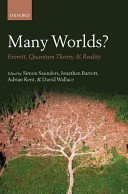 Many Worlds? Everett, Quantum Theory, and Reality was published
by Oxford University Press in June 2010.
Many Worlds? Everett, Quantum Theory, and Reality was published
by Oxford University Press in June 2010.
A Comparison of Quantum Oracles
Many Worlds Quantum Theory and its problems
Our book
 Many Worlds? Everett, Quantum Theory, and Reality was published
by Oxford University Press in June 2010.
Many Worlds? Everett, Quantum Theory, and Reality was published
by Oxford University Press in June 2010.
More information can be found on the book's
amazon page.
Unlike the other editors, I'm sceptical about whether
many-worlds quantum theory can actually be made into a well-defined
and scientifically useful theory, and one of my contributions
to the book is the question mark in the title.
Another is my chapter
One World Versus Many, which includes
an extended critique of recent
attempts to make sense of Everett's many-worlds ideas.
Synopsis
What would it mean to apply quantum theory, without restriction and without involving any notion of measurement and state reduction, to the whole universe? What would realism about the quantum state then imply?
This book brings together an illustrious team of philosophers and physicists to debate these questions. The contributors broadly agree on the need, or aspiration, for a realist theory that unites micro- and macro-worlds. But they disagree on what this implies. Some argue that if unitary quantum evolution has unrestricted application, and if the quantum state is taken to be something physically real, then this universe emerges from the quantum state as one of countless others, constantly branching in time, all of which are real. The result, they argue, is many worlds quantum theory, also known as the Everett interpretation of quantum mechanics. No other realist interpretation of unitary quantum theory has ever been found.
Others argue in reply that this picture of many worlds is in no sense inherent to quantum theory, or fails to make physical sense, or is scientifically inadequate. The stuff of these worlds, what they are made of, is never adequately explained, nor are the worlds precisely defined; ordinary ideas about time and identity over time are compromised; no satisfactory role or substitute for probability can be found in many worlds theories; they can't explain experimental data; anyway, there are attractive realist alternatives to many worlds.
Twenty original essays, accompanied by commentaries and discussions, examine these claims and counterclaims in depth. They consider questions of ontology - the existence of worlds; probability - whether and how probability can be related to the branching structure of the quantum state; alternatives to many worlds - whether there are one-world realist interpretations of quantum theory that leave quantum dynamics unchanged; and open questions even given many worlds, including the multiverse concept as it has arisen elsewhere in modern cosmology. A comprehensive introduction lays out the main arguments of the book, which provides a state-of-the-art guide to many worlds quantum theory and its problems.
Reviews
A review by Robert Wald, published in Classical and Quantum Gravity, is here.Here are reviews by Jeremy Butterfield, Amit Hagar and Peter Lewis. (These links may require subscription.) A more recent and detailed review by Guido Bacciagaluppi appeared in Metascience .
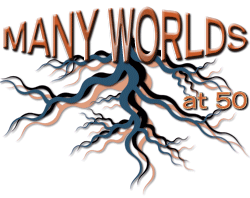 With Jonathan Barrett and David Wallace,
I coorganised the "Many Worlds at 50" conference held at Perimeter
Institute in September 2007 to mark the 50th anniversary of
Everett's original paper.
With Jonathan Barrett and David Wallace,
I coorganised the "Many Worlds at 50" conference held at Perimeter
Institute in September 2007 to mark the 50th anniversary of
Everett's original paper.

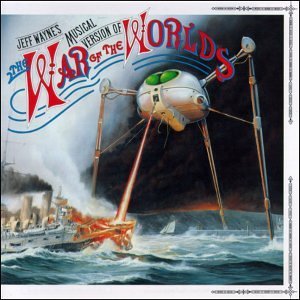 The MIT Technology Review blog's
The MIT Technology Review blog's
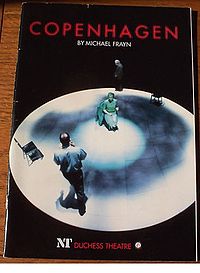 I often go along to the
I often go along to the